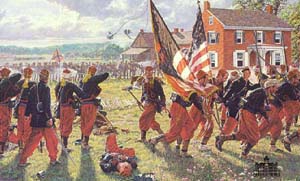Civil War Battles |
Colonial Wars |
American Wars |
Link To This Page — Contact Us —
The Fight at The Peach Orchard
July 1-3, 1863 in Gettysburg, Pennsylvania
 |
While the right wing of Kershaw's brigade attacked into the Wheatfield, its left wing wheeled left to attack the Pennsylvania troops in the brigade of Brig. Gen. Charles K. Graham, the right flank of Birney's line, where 30 guns from the III Corps and the Artillery Reserve attempted to hold the sector. The South Carolinians were subjected to infantry volleys from the Peach Orchard and canister from all along the line. Suddenly someone unknown shouted a false command, and the attacking regiments turned to their right, toward the Wheatfield, which presented their left flank to the batteries. Kershaw later wrote, "Hundreds of the bravest and best men of Carolina fell, victims of this fatal blunder."
Meanwhile, the two brigades on McLaws's left—Barksdale's in front and Wofford's behind—charged directly into the Peach Orchard, the point of the salient in Sickles's line. Gen. Barksdale led the charge on horseback, long hair flowing in the wind, sword waving in the air. Brig. Gen. Andrew A. Humphreys's division had only about 1,000 men to cover the 500 yards from the Peach Orchard northward along the Emmitsburg Road to the lane leading to the Abraham Trostle farm. Some were still facing south, from where they had been firing on Kershaw's brigade, so they were hit in their vulnerable flank. Barksdale's 1,600 Mississippians wheeled left against the flank of Humphreys's division, collapsing their line, regiment by regiment. Graham's brigade retreated back toward Cemetery Ridge; Graham had two horses shot under them, was hit by a shell fragment, and a bullet in his upper body. He was eventually captured by the 21st Mississippi. Wofford's men dealt with the defenders of the orchard.
 Click To Enlarge |
As Barksdale's men pushed toward Sickles's headquarters near the Trostle barn, the general and his staff began to move to the rear, when a cannonball caught Sickles in the right leg. He was carried off in a stretcher, sitting up and puffing on his cigar, attempting to encourage his men. That evening his leg was amputated, and he returned to Washington, D.C. Gen. Birney assumed command of the III Corps, which was soon rendered ineffective as a fighting force.
The relentless infantry charges posed extreme danger to the Union artillery batteries in the orchard and on the Wheatfield Road, and they were forced to withdraw under pressure. The six Napoleons of Capt. John Bigelow's 9th Massachusetts battery, on the left of the line, "retired by prolonge": a technique rarely used in which the cannon was dragged backwards as it fired rapidly, the movement aided by the gun's recoil. By the time they reach the Trostle house, they were told to hold the position to cover the infantry retreat, but they were eventually overrun by troops of the 21st Mississippi, who captured three of their guns.
Humphreys's fate was sealed when the Confederate en echelon attack continued and his front and right flank began to be assaulted by the Third Corps division of Richard H. Anderson on Cemetery Ridge.
